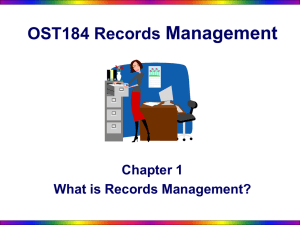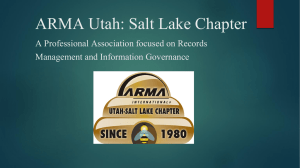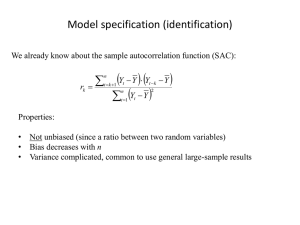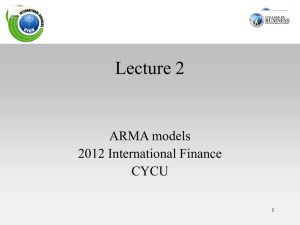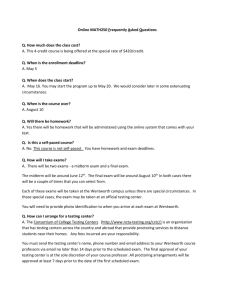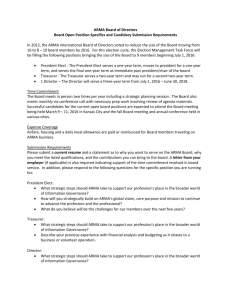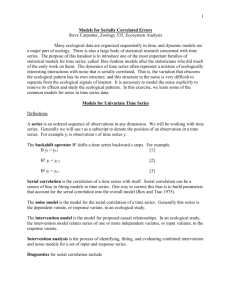STA 477 - nau.edu
advertisement
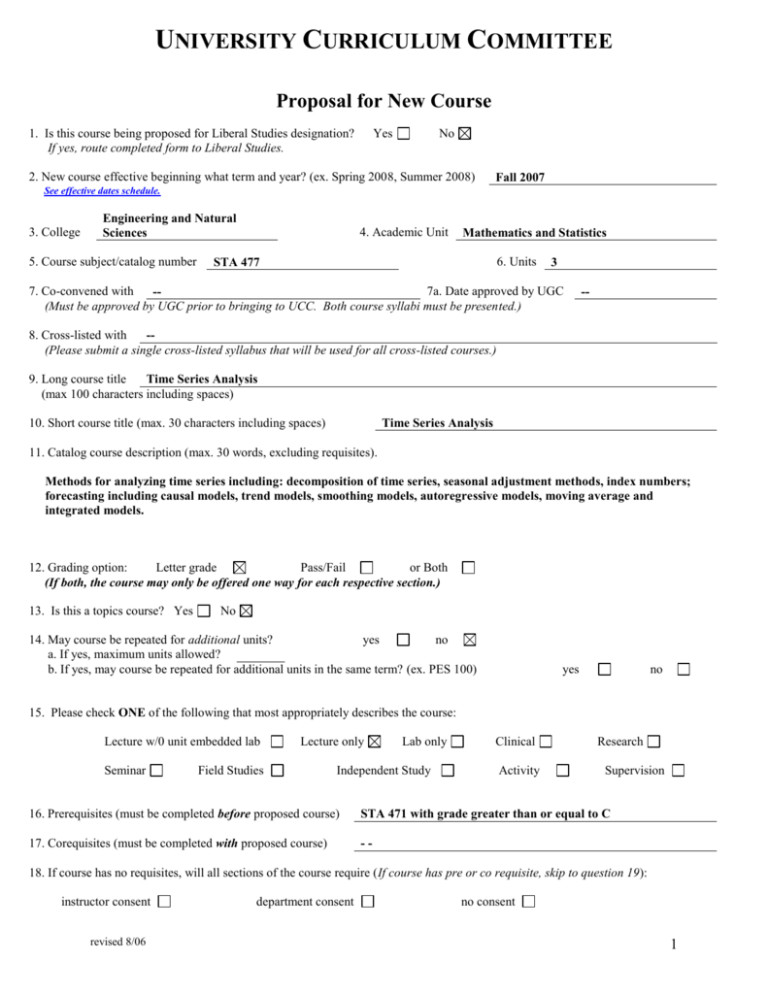
UNIVERSITY CURRICULUM COMMITTEE Proposal for New Course 1. Is this course being proposed for Liberal Studies designation? If yes, route completed form to Liberal Studies. Yes No 2. New course effective beginning what term and year? (ex. Spring 2008, Summer 2008) Fall 2007 See effective dates schedule. 3. College Engineering and Natural Sciences 5. Course subject/catalog number 4. Academic Unit Mathematics and Statistics 6. Units STA 477 3 7. Co-convened with 7a. Date approved by UGC -(Must be approved by UGC prior to bringing to UCC. Both course syllabi must be presented.) -- 8. Cross-listed with -(Please submit a single cross-listed syllabus that will be used for all cross-listed courses.) 9. Long course title Time Series Analysis (max 100 characters including spaces) 10. Short course title (max. 30 characters including spaces) Time Series Analysis 11. Catalog course description (max. 30 words, excluding requisites). Methods for analyzing time series including: decomposition of time series, seasonal adjustment methods, index numbers; forecasting including causal models, trend models, smoothing models, autoregressive models, moving average and integrated models. 12. Grading option: Letter grade Pass/Fail or Both (If both, the course may only be offered one way for each respective section.) 13. Is this a topics course? Yes No 14. May course be repeated for additional units? yes no a. If yes, maximum units allowed? b. If yes, may course be repeated for additional units in the same term? (ex. PES 100) yes no 15. Please check ONE of the following that most appropriately describes the course: Lecture w/0 unit embedded lab Seminar Lecture only Field Studies Lab only Independent Study Clinical Activity Research Supervision 16. Prerequisites (must be completed before proposed course) STA 471 with grade greater than or equal to C 17. Corequisites (must be completed with proposed course) -- 18. If course has no requisites, will all sections of the course require (If course has pre or co requisite, skip to question 19): instructor consent revised 8/06 department consent no consent 1 19. Is the course needed for a plan of study (major, minor, certificate)? yes no Name of new plan? BS Mathematics – Extended (Actuarial Science and Statistics subplans) Note: A new plan or plan change form must be submitted with this request. 20. Does course duplicate content of existing courses within or outside of your college? yes no If yes, list any courses this course may have duplicative material with and estimate percentage of duplication: Please attach letters of support from each department whose course is listed above. 21. Will this course affect other academic plans, academic units, or enrollment? yes If yes, explain in justification and provide supporting documentation from the affected departments. 22. Is a potential equivalent course offered at a community college (lower division only)? If yes, does it require listing in the Course Equivalency Guide? yes Please list, if known, the institution, subject/catalog number of the course. yes no no no 23. Justification for new course, including unique features if applicable. (Attach proposed syllabus in the approved university format). The area of time series analysis is important in both statistics and actuarial science. It forms part of a professional exam offered by the Society of Actuaries. Our lack of coursework in this area has disadvantaged our actuarial science majors. The presence of this course will potentially allow our students to substitute STA 471/477 for the professional exam and may serve as a recruitment tool for us. [This substitution must be approved by the Society of Actuaries.] More generally, the analysis of time series data is useful in many disciplines and the forecasting of future trends is important in, for example, a business setting. The course will therefore serve to enhance the resumes of our statistics majors. 24. Names of current faculty qualified to teach this course Brent Burch, Roy St. Laurent, Phil Turk, Jin Wang 25. If course will require additional faculty, space, or equipment, how will these requirements be satisfied? -26. Will present library holdings support this course? yes revised 8/06 no 2 If the course being submitted for approval is NOT a LIBERAL STUDIES course, please go to step 42. LIBERAL STUDIES ONLY Contact name: Contact email: Dept. Chair name: Dept. Chair email: College Contact name : College Contact email: 27. This course is a Single section Multi-section 28. List names of faculty who may teach this course: 29. Section enrollment cap: If this course is being submitted for approval as a new LIBERAL STUDIES course, please complete questions 30-33. OR If this course is being submitted for approval as a new JUNIOR LEVEL WRITING course, please complete questions 37-38. OR If this course is being submitted for approval as a new SENIOR CAPSTONE course, please complete questions 39-41. NEW LIBERAL STUDIES COURSE 30. Thematic Focus (check all that apply): If a topics course, must apply to ALL sections. Environmental Consciousness Technology and Its Impact Valuing the Diversity of Human Experience 31. Distribution Block (check one): If a topics course, must apply to ALL sections. Aesthetic and Humanistic Inquiry Science/Applied Science Cultural Understanding Lab Science Social and Political Worlds 32. Skills (check two): If a topics course, must apply to ALL sections. Creative Thinking Critical Reading Effective Oral Communication Effective Writing Critical Thinking Ethical Reasoning Quantitative/Spatial Analysis Scientific Inquiry Use of Technology 33. Is this a topics course? Yes No If YES, please complete questions 34-36. If NO, please go to question 42. TOPICS COURSE ONLY 34. Identify the Student Learning Outcomes that will be found in ALL topic syllabi offered under this course number. 35. Explain by what method(s) Student Learning Outcomes will be assessed in ALL topic syllabi offered under this course number. 36. Please attach an example of a Topic Syllabus offered under this course number. GO TO question revised42 8/06 3 NEW JUNIOR LEVEL WRITING COURSE (refer to question 19) 37. To which degree programs offered by your department/academic unit does this proposal apply? 38. Do you intend to offer ABC 300 and ABC 300W? yes If no, please submit a course delete form for the ABC 300. no GO TO question 42 NEW SENIOR CAPSTONE COURSE (refer to question 19) 39. To which degree programs offered by your department/academic unit does this proposal apply? 40. Does this proposal replace or modify an existing course or experience? yes If yes, which course(s)? no 41. Do you intend to offer ABC 400 and ABC 400C? yes no If no, please submit a course delete form for the ABC 400. 42. Approvals Department Chair (if appropriate) Date Chair of college curriculum committee Date Dean of college Date For Committees use only For Liberal Studies Committee Date Action taken: _____________________ Approved as submitted For University Curriculum Committee ___________________________ Approved as modified Date Action taken: Approved as submitted revised 8/06 Approved as modified 4 College of Engineering & Natural Sciences Department of Mathematics & Statistics STA 477: TIME SERIES ANALYSIS General Information: STA 477 is a three-credit hour course meeting 150 minutes each week. Prerequisites: A grade of C or better in MAT 471. Catalog Description: Methods for analyzing time series including: decomposition of time series, seasonal adjustment methods, index numbers; forecasting models including causal models, trend models, smoothing models, autoregressive models, moving average and integrated models. Prerequisite: STA 471 with grade greater than or equal to C Course Description: A time series is a collection of observations made sequentially through time. Examples occur in a variety of fields, ranging from economics to engineering. The particular essence of time series analysis is its concern with the nature of dependence among the members of the sequence of random variables. Specific methods of analyzing time series have been developed and constitute an important area of statistics. The methods covered in the course include: decomposition of time series, seasonal adjustment methods, index numbers; forecasting models including causal models, trend models, smoothing models, autoregressive models, moving average and integrated models. Student Learning Outcomes Upon successful completion of the course students will be able to: 1. Understand the important features of a given time series and be able to extract these in order to build a model. 2. Understand the definitions of a wide variety of models, and be able to put in place the necessary steps to build such models. 3. Be able to calculate things such as autocorrelation functions, regions of admissible parameter values, forecasts, etc. 4. Be able to apply statistical software package(s) in the analysis of time series. 5. Be able to interpret the output of statistical software package(s) in the analysis of time series. Course Structure and Approach: The class will meet for three 50-minute periods per week for the fifteen week semester. Class meetings will consist of lectures, discussions and demonstration and use of statistical software. Textbook: A textbook is required for this course. There are many possible textbooks available, including: The Analysis of Time Series: An Introduction, Chris Chatfield, 6th ed., (2004). Topics will be selected from Chapters 1-5, 13 and 14 of the text. If time permits, further material may be selected from Chapter 8. revised 8/06 5 Computer Lab: A statistical software package (e.g. R) will be used in lectures and instructions to its use provided in handouts throughout the course. Computer-related code and output will be discussed. The students will be required to use the package for homework assignments and exams. Course Outline / Timeline 1. Introduction – 3 days Some Representative Time Series. Terminology Objectiveness of Time Series Analysis Problems of Autocorrelation 2. Simple Descriptive Techniques – 10 days Types of Variation Stationary Time Series The Time Plot Transformations Estimation and Elimination of Trend in the Absence of Seasonality Estimation and Elimination of Trend and Seasonality Tests of Randomness Handling Real Data 3. Some Time Series Models – 19 days Stochastic Processes and Their Properties Stationary Processes and Autocorrelation Autocorrelation and the Correlogram Some Properties of the Population ACV.F and the Population AC.F Moving Average Process MA(q) Autoregressive Processes AR(p) Autoregressive Moving Average Model ARMA (1,1) 4. Estimation of the Mean and the ACV.F– 4 days Estimation of the Mean Estimation of the Populations ACV.F and AC.F 5. ARMA models – 4 days ARMA Processes AC.F and PAC.F of ARMA(p,q) Forecasting ARMA Processes 6. Integrated ARMA or ARIMA Models – 3 days Building ARIMA Models Seasonal ARMA Model Mixed Seasonal ARMA 7. Modeling - 2 days Assessment Selection revised 8/06 6 Assessment of Student Learning Outcomes Student progress toward achieving course objectives will be measured in a variety of ways: Student understanding of basic concepts and ability to properly apply the appropriate model will be evaluated by some or all of the following: regular homework assignments (at least weekly); tests and quizzes; and a comprehensive final examination. Student ability to properly use technology (statistical software package(s)) in the analysis of time series will be evaluated by special technology-based exercises on homework assignments and, possibly, in take-home portions of exams. Student understanding of methodology and ability to correctly interpret and explain concepts related to time series will be evaluated through class discussion, homework problems and test questions. The precise nature of the assessments may vary from instructor to instructor. The following is one possible scheme: A number of homework assignments will be given during the semester. They will be weighted equally and may be done in groups. Two exams will be given – a midterm and a comprehensive final. Successful completion of the final is necessary to pass the class. The in-class component of the exams are cosed book although students will be provided with necessary formulas. The format for the in-class portion of the exams will range from multiple choice, short answer and some longer ‘show your work’ problems. Take-home components of the two exams will be constructed in a similar way to homework assignments and will emphasize computer application. But in contrast to homework assignments, these take-home components of the exams are to be done independently using only class notes and the textbook. Grading System: This may vary from instructor to instructor, but a standard scale based on total points earned (A: 90% or higher; B: 80-89%, etc.) is suggested as a starting point. Course Policies: These may vary from instructor to instructor. The following are suggested: Make-up tests will not be given except for institutional reasons Attendance at all class session is expected. Academic dishonesty will not be tolerated. University policies: Students are responsible for the following University policies: Safe Environment, Students with Disabilities, Institutional Review Board, Academic Integrity, and the Academic Contact Hour Policy. A copy of these policies may be downloaded from the web site http://jan.ucc.nau.edu/academicadmin/policy.doc. revised 8/06 7
